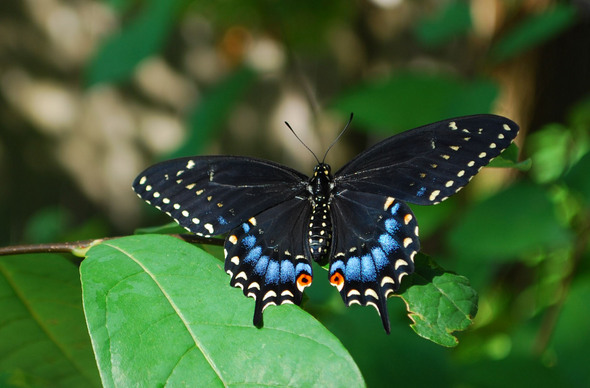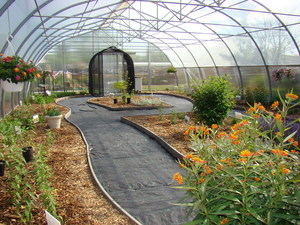Native butterflies in our midst - new section of greenhouse provides a resource for attracting these beautiful insects with native plants

A native Black Swallowtail butterfly (Papilio polyxenes) rests on a Spicebush (Lindera benzoin) shortly after emerging from its chrysalis.
Rick Meader | Contributor
As we’ve discussed before in this column, native plants are outstanding hosts for native butterflies, and in some cases, like monarchs or some swallowtails, native plants are the only hosts. Without them, their caterpillars will have nothing to feed on, because they have no substitute hosts upon which they can feed.
Over thousands of years, they have developed specialized tastes and digestive systems which can handle only the special chemistry of their host plants. Monarchs must have milkweed plants to survive and Spicebush swallowtails must have Spicebush or Sassafras to survive.
Some native butterflies are fortunate to also have some non-native plants as hosts. These non-natives are related closely enough to the caterpillar’s native hosts to have chemistry similar to the native, so the caterpillars can survive on it.
Such is the case with the Black Swallowtail, whose host plants include members of the parsley family (Umbelliferae) including non-native carrot, parsley, dill, fennel and eve Queen Anne's lace. While it originally was dependent on water hemlock (Cicuta maculata Linn.), water parsnip (Sium cicutaefolium), marsh pennywort (Hydrocotyle) and angelicas (A. atropurpurea), it has seemed to switch to prefer the non-native hosts, which is helpful if you’re trying to attract them to your yard, because the easily-acquired non-natives can be grown in containers in your yard or on your patio.
For many native butterflies, however, there are no such happy substitutes.
Unless you have a lot of land with a variety of healthy native landscapes near your home, or a fennel farm, you’re not likely to see many of our native butterflies flitting about your home or garden. Of course, if you’re Brenda Dziedzic, adoptive mother of butterflies, whose suburban garden is a smorgasbord for butterflies and their larvae among a sea of asphalt and lawn, you’ll see them all on a quick walk in your own one-sixth of an acre.
Fortunately, for the rest of us, Brenda has arranged with Barson’s Greenhouse (6414 Merriman Road, Westland) to build a Butterfly House that will be free and open to the general public, beginning Friday, June 1.
Unlike many butterfly houses you may visit, this will specialize in native butterflies. Monarchs, American Ladies, Spicebush Swallowtails, Black Swallowtails, Eastern Tiger Swallowtails, Red Admirals and Question Marks will provide a load of color and activity sure to delight the young and old who wander its paths. Caterpillars of Spicebush Swallowtails, Black Swallowtails, Red Admirals, American Ladies and Giant Swallowtails will also be in attendance.
And, for native plant enthusiasts like me, you will see the butterflies engaging with their native hosts in the house. Even better, you will be able to purchase the native plants you see in these interactions right there, at Barson’s Greenhouse, so you can attract some of them to your own garden.

Brenda's Greenhouse under construction. Opens this Friday, June 1 with lots of native butterflies and caterpillars in attendance!
Photo by Brenda Dziedzic
The grand opening for this outstanding learning resource is this coming Friday, June 1, from 1-5 p.m. After that, the hours in June will be 1-5 p.m. on Tuesdays, Wednesdays, Fridays and Sundays and 11 a.m.-5 p.m. on Saturdays. The butterflies and caterpillars take the day off on Mondays and Wednesdays. In July, August and early September, the house will have extended hours.
For more information, check out Brenda’s website at www.butterfliesinthegarden.com, or e-mail her at HappyButterflying@yahoo.com. I highly recommend that you visit the Butterfly House soon to be inspired to add plants to your own oasis this year, so your home will become another home for the butterflies that you most enjoy.
This week, blooming in our yard are Golden Alexander, Yarrow, Blue-eyed Grass, Spiderwort, False Solomon’s Seal, Solomon’s Seal, Foxglove Beardtongue, Carolina Rose, Common Cinquefoil, and Black Raspberry. We’re into the period where the strongest feature of my woodland/savanna plantings is their foliage as the dominant color is now green, and the only prairie plantings that are blooming is the Foxglove Beardtongue, but the variety of textures and plant heights is still pretty fun to see. Get out and enjoy nature, everyone!
Rick is a local landscape architect with a special interest in all things natural, including creating designs that include a lot of native plants (and the critters they support). You can contact him at yourland1824@gmail.com.


Comments
Rick Meader
Thu, May 31, 2012 : 12:23 a.m.
Congratulations, Sarah! We've learned how to spot butterfly eggs on plants and bring them in to raise them from Brenda. Right now, we have 22 monarch caterpillars/chrysalis(es?) growing in containers in our house. It's fun to raise them and release them, knowing that we have helped protect them from predators as they grew, increasing the butterfly population. We grew several black swallowtails last year, too!
Sarah Rigg
Tue, May 29, 2012 : 12:15 p.m.
We get those beautiful black swallowtails in our yard a lot - they must like all the dill that has crept into the sidewalk cracks and the lawn. We have also been letting milkweed grow in the back yard for the last 3 years, but this is the first year I actually saw a monarch caterpillar on one of the plants.